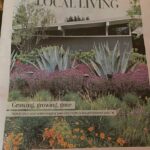

Mike Hayman found an unexpected treasure last month while searching through photos he had taken of Louise “Weesie” Smith in her Birmingham garden on April 15, 2015. Mike sent me an unforgettable image that depicted Weesie standing beneath an arbor covered with blooms of Chinese fringe tree (Chionanthus retusus). Mike, Leslie Pancratz and I had traveled down for this story – Mike photographed while Leslie Pancratz wrote.
Mike Hayman captured this photograph. Weesie Smith can be seen here standing beneath her arbor with Chinese fringe tree.
Since December 1991, Louise Goodall Smith and Kurt Erwin Bluemel’s plants shared with me more than 25 years ago have brought back fond memories. A disjunct buckeye dug off a roadside near Haneyville Alabama and grape hyacinth from an army base near Moscow Russia are currently blooming here in Salvisa; although neither are top choices among plant enthusiasts. But for me personally it doesn’t matter; these flowers hold special memories and they matter so much more than any hit parade of love;
People remember Weesie for her dedication to gardening, particularly native species. She was known for being smart, tireless, curious and unassuming – and even though she once told me “I’m just a dirt gardener”, Weesie remains remembered as an unwavering champion of natural areas conservation throughout Alabama.
At 33 years old and knowing very little about rock garden plants, I approached Weesie at Asheville’s 50th Anniversary Meeting of the North American Rock Garden Society (NARGS). She was standing alone; I introduced myself and introduced myself as well. Weesie once owned an expansive garden on Pine Ridge Road but eventually downsized to an intricate suburban garden filled with beautiful and rare species found only there; other areas had smaller spaces containing gorgeous displays of blooms as well.
Weesie with crossvines of Bignonia capreolata
Kurt Bluemel of Fallston, Maryland and garden designer known as Der Gras Konig–the King of Grasses–first entered my life at an Asheville NARGS meeting. (I don’t know whether Weesie met him then.) Kurt was charismatic, self-assured and artistic–an exceptional combination of characteristics–barrel chested, self-assured, artistically demanding and sporting an equally full gray head of hair which rivaled that of Cesar Romero’s. We became friends and colleagues within the Ratzeputz Gang–a traveling cadre of plant nuts and prime rib lovers (I always enjoyed steak whenever possible but hanging out with my Ratzeputz boys was like having steak every night!). Our group was named for an unpleasant tasting German liqueur we encountered at an evening German rathskeller one evening during our travels which we encountered one evening back in 1987!
Kurt at Racetrack Playa in Death Valley. 2014.
On a driving trip through central Alabama near Haneyville with her brother-in-law, G.E. Kidder Smith (an architectural writer and photographer), Weesie saw an unusual yellow buckeye (Aesculus glabra). Weesie remembered marking it in her mind and decided she’d return someday and get one for herself.
Mike Dirr called this variety Aesculus glabra var. nana and thought it to be rare until Pennsylvania plantsman Bill Barnes realized it was in fact part of an unusual species called Texas Buckeye (Aesculus glabra var. arguta). Straight species Aesculus glabra thrives along moist woodland edges in parts of eastern U.S. and Canada – it was Weesie’s Buckeye to me and has now reached 8 feet tall!
Weesie’s Buckeye with Sedum Angelina
Bluemel’s modest grape hyacinth was collected in Soviet Russia’s lower Pamir Mountains of what is now Uzbekistan in July 1989 a few months before the Berlin Wall fell, according to Erik Weinstock, Bluemel’s stepson. Erik describes this journey as equal parts botanic exploration and spycraft. They were traveling with Czech botanist Josef Halda. Though KGB agents kept an eye out, Halda knew how to deal with nosy Soviet minders; seed collectors would sneak out the door early each morning and hitch rides into Pamirs with taxi drivers known as “black taxis.” Erik remembered being near a Soviet missile silo one day, perhaps near where grape hyacinth was collected in a field. Halda identified it as Leopolida (Muscari) pamirica but I’m uncertain if this species is truly from Pamir or simply labeled to make identification easier; either way it makes for a great tale! I still don’t have an accurate ID but regardless it remains interesting!
Weesie and Kurt are with me every April. A buckeye tree and grape hyacinth remind me of them every year; these memories bring great comfort this week when we in Louisville mourned an act of mass murder close to home. Today’s garden was my peaceful respite.







